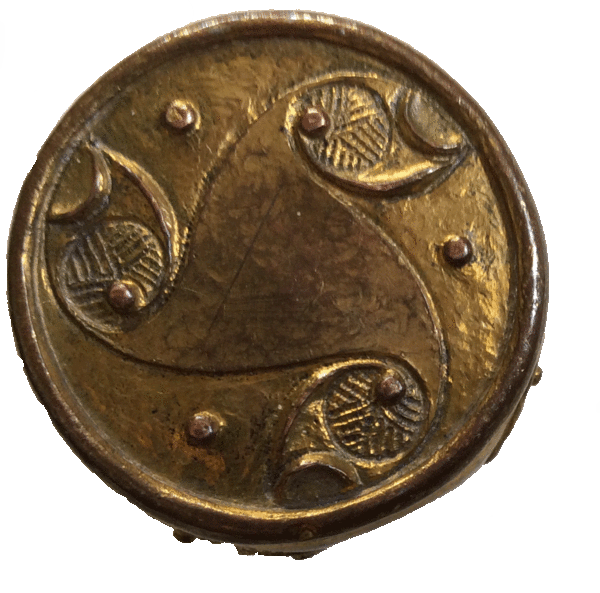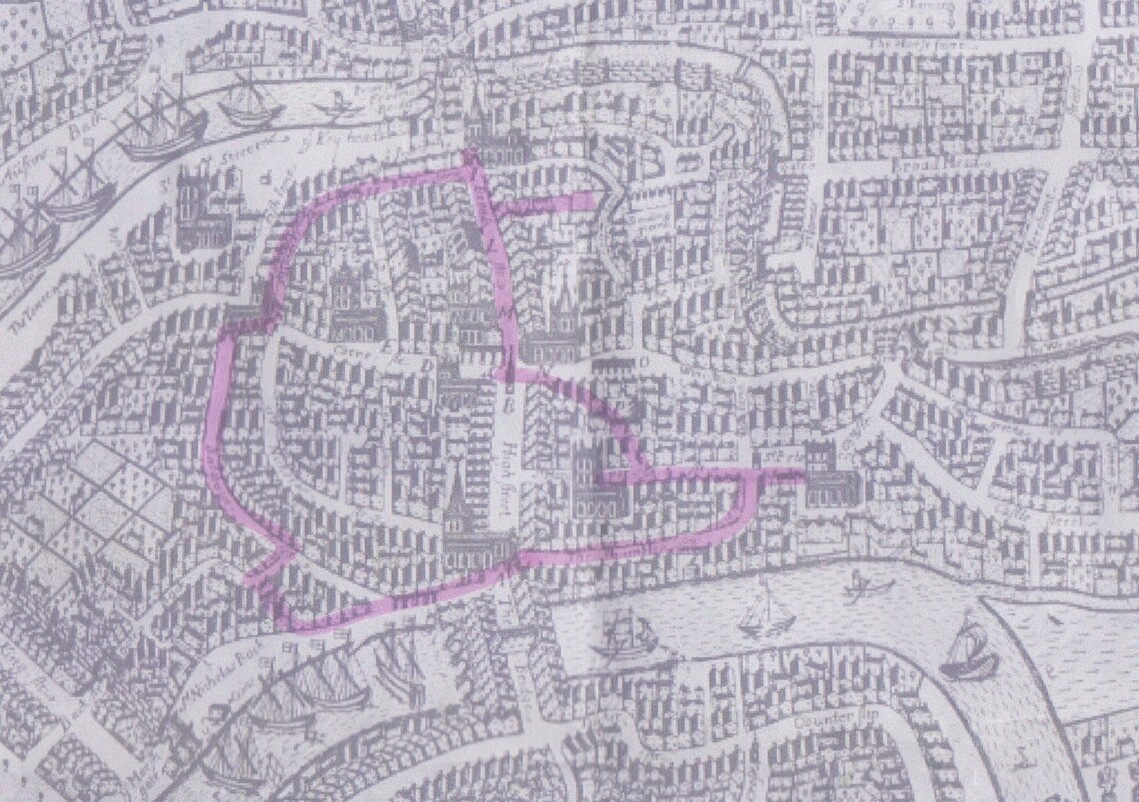With Bob Jones, Thursday 18th July 2019.
13 members of the group met Bob at the north end of Bristol bridge opposite St Peter's church. Interestingly for the group, our visit coincided with the Extinction Rebellion demonstration that had lead to the closure of roads and attendant chaos in the centre of Bristol for much of the previous week.
Bob gave us copies of Millerd's map of 1673 (see below) to follow our route.
Bob explained that the settlement of Bristol grew up around the crossing of the River Avon. At this point, rocks stick out from both banks making it a good site for first of all a ferry, and later a bridge. Bob thinks that there would have been several Saxon manors in the area each with their own church which evolved into the small parishes of the old town. The Avon was the boundary between Mercia and Wessex and there would have been a bridgehead on the south bank defended by a ditch. A coin minted in Bristol from the reign of Aethelred from about 1010 showing the bridge, was found in Sweden confirming the town had become an important settlement by that date. References are made in the Anglo Saxon chronicle to Harold Godwinson (later King Harold) taking boats from the town in 1052 and 1062.
On the opposite bank, the Knights Templar and the church of St Mary Redcliffe held land. These areas were outside Bristol until they were included in the new City and County of Bristol, created in 1373 from parts of Gloucestershire and Somerset. Bristol was the first city outside of London to get this status.
Bob explained that the church of St Nicholas was built into the city wall with the gate to the bridge beside it. That church, apart from the medieval crypt, was destroyed to widen the road and the present church was built between 1762 and 1769. It was badly damaged in World War II.
From there we left the noise of the demonstration and walked to Castle Park and the church of St Peter's. This is the oldest church in Bristol dating from 1106. It was destroyed in World War II. In front of it ran Dolphin or Defence St. From there we went to the ruins and tower of St Mary-le-Port church hidden behind the old Norwich Union and the Bank of England buildings It has been excavated and has Saxon foundations.
Next we went on to the junction of the High Street, Corn St and Broad St where the Bristol Cross, now at Stourhead, once stood. The west side of the High St leading back to Bristol Bridge is made up of largely medieval houses that were once cook shops, early takeaways! The Dutch House, a famous Bristol landmark was here until it was destroyed in WWII.
Around the crossing there were 3 churches. All Saints, Corn St has a nave from the 12th and 15th centuries and a tower from 1716. The church was used by the Kalendar brotherhood, a shadowy group of priests and laymen. They had a library there which in 1464 was made available to anyone who wished to study there making it the first public library in England. There is a monument to Edward Colston in the church.
Opposite the church is the Old Council House ( now the Registrars offices). This was built on the site of St Ewen's church from the Middle Ages, destroyed in 1820 when the Council House was built to a neo-classical design by Robert Smirke, who also designed the British Museum. On the other side of Broad St, is Christchurch with St Ewen, built in 1786/91 with its automaton clock (currently being restored).
Further down Corn St we could see the Bristol Nails where merchants made their deals . These are outside the Exchange with its clock with a separate hand to show “Bristol time”. We walked down Broad street passing the Grand Hotel and Guild Hall before turning in to Tailor's Court. This contains the Merchant Taylor's Guild Hall (1740) with its decorated porch hood showing their coat of arms and the graveyard of St John in the Wall church. The Merchant Taylors went to violent lengths to stop the church members crossing what they considered to be their land to get to the graveyard. This little corner of old Bristol should be a gem but currently it is in a very neglected state.
We returned to Broad St and went north passing a wonderful Art Nouveaux front before we reached St John in the Wall church and city gate, both from the 14th century (the gate was modified in the 19th century). Inside the church are memorials to Walter Frampton (1357) who served as mayor of Bristol and the monk Thomas Rowley (1478). Thomas Chatterton claimed to have found Rowley's manuscripts but they were in fact his own work. In niches above the Arch are statues of Brenmus and Belinus, the mythical founders of Bristol. The arch would have been the main entrance to the city.
From St John's we made our way along firstly the narrow Bell Lane to Small St and then followed the even narrower St Leonard St, back to Corn St., where our tour ended.
Bob gave us an extremely interesting tour, showing us parts of old Bristol that were new to many of us.
Tom Chown 19.07.2019

